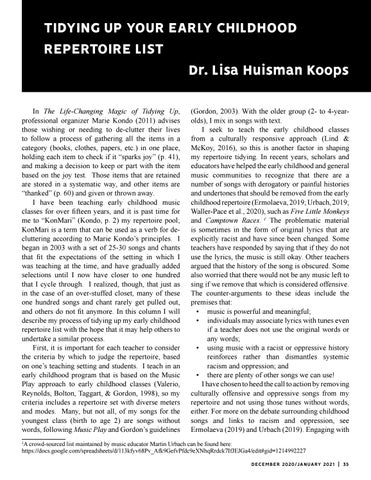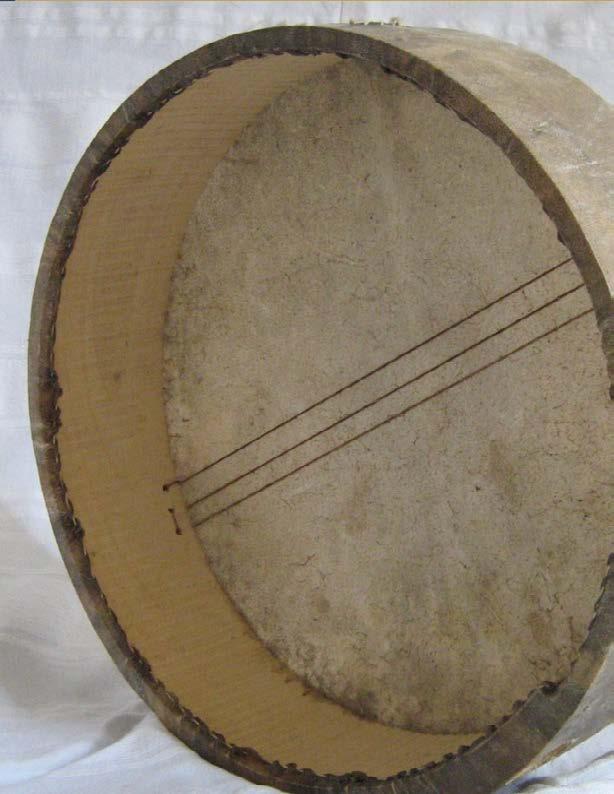TIDYING UP YOUR EARLY CHILDHOOD REPERTOIRE LIST Dr. Lisa Huisman Koops In The Life-Changing Magic of Tidying Up, professional organizer Marie Kondo (2011) advises those wishing or needing to de-clutter their lives to follow a process of gathering all the items in a category (books, clothes, papers, etc.) in one place, holding each item to check if it “sparks joy” (p. 41), and making a decision to keep or part with the item based on the joy test. Those items that are retained are stored in a systematic way, and other items are “thanked” (p. 60) and given or thrown away. I have been teaching early childhood music classes for over fifteen years, and it is past time for me to “KonMari” (Kondo, p. 2) my repertoire pool; KonMari is a term that can be used as a verb for decluttering according to Marie Kondo’s principles. I began in 2003 with a set of 25-30 songs and chants that fit the expectations of the setting in which I was teaching at the time, and have gradually added selections until I now have closer to one hundred that I cycle through. I realized, though, that just as in the case of an over-stuffed closet, many of these one hundred songs and chant rarely get pulled out, and others do not fit anymore. In this column I will describe my process of tidying up my early childhood repertoire list with the hope that it may help others to undertake a similar process. First, it is important for each teacher to consider the criteria by which to judge the repertoire, based on one’s teaching setting and students. I teach in an early childhood program that is based on the Music Play approach to early childhood classes (Valerio, Reynolds, Bolton, Taggart, & Gordon, 1998), so my criteria includes a repertoire set with diverse meters and modes. Many, but not all, of my songs for the youngest class (birth to age 2) are songs without words, following Music Play and Gordon’s guidelines
(Gordon, 2003). With the older group (2- to 4-yearolds), I mix in songs with text. I seek to teach the early childhood classes from a culturally responsive approach (Lind & McKoy, 2016), so this is another factor in shaping my repertoire tidying. In recent years, scholars and educators have helped the early childhood and general music communities to recognize that there are a number of songs with derogatory or painful histories and undertones that should be removed from the early childhood repertoire (Ermolaeva, 2019; Urbach, 2019; Waller-Pace et al., 2020), such as Five Little Monkeys and Camptown Races. 1 The problematic material is sometimes in the form of original lyrics that are explicitly racist and have since been changed. Some teachers have responded by saying that if they do not use the lyrics, the music is still okay. Other teachers argued that the history of the song is obscured. Some also worried that there would not be any music left to sing if we remove that which is considered offensive. The counter-arguments to these ideas include the premises that: • music is powerful and meaningful; • individuals may associate lyrics with tunes even if a teacher does not use the original words or any words; • using music with a racist or oppressive history reinforces rather than dismantles systemic racism and oppression; and • there are plenty of other songs we can use! I have chosen to heed the call to action by removing culturally offensive and oppressive songs from my repertoire and not using those tunes without words, either. For more on the debate surrounding childhood songs and links to racism and oppression, see Ermolaeva (2019) and Urbach (2019). Engaging with
1 A crowd-sourced list maintained by music educator Martin Urbach can be found here: https://docs.google.com/spreadsheets/d/113kfyv68Pv_Afk9GefvPfdc9eXNhqRrdck7IfJEJGa4/edit#gid=1214992227
DECEMBER 2020/JANUARY 2021 | 35





